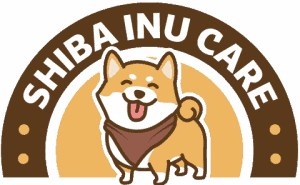This post contains affiliate links.
With so many different types of dog brushes out there I struggled to pick the best brush for my Shiba. So I bought multiple and tried them all out.
The best type of brush for Shiba Inus seamlessly removes fur from their loose undercoat with minimal discomfort and as little damage to their overcoat as possible. Those specific goals lead Slicker Brushes to be the best type to groom a Shiba Inu with. They even help spread natural oils.
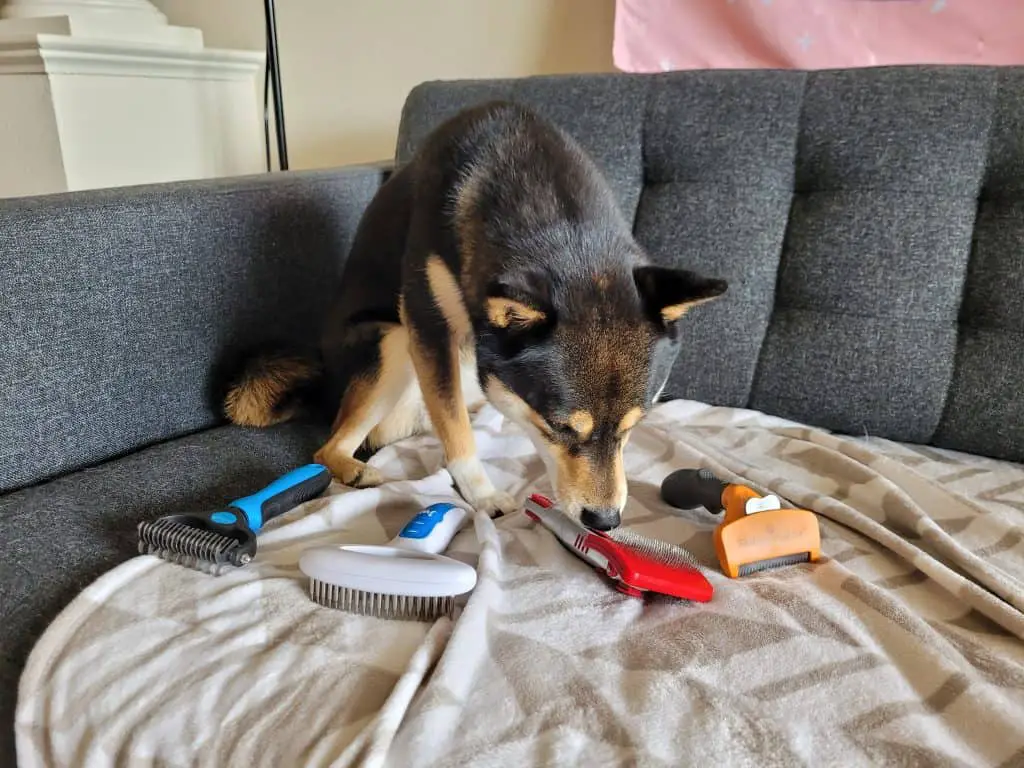
Everything I’ve learned by researching and testing different styles of dog brushes is listed below. If you want to see which type of brush is best for Shiba Inus, feel free to keep reading.
What To Look For In A Brush
Shiba Inus have an over-under approach to their coat. This is great when it comes to the different roles they specialize in in terms of keeping them clean and healthy. But is the source of their seemingly never-ending shedding.
While browsing for a dog brush there are 3 main things we want for our dog and 5 for us. For our dog, we want a brush that will:
- Seamlessly remove their loose undercoat.
- Minimize damage to their overcoat.
- And cause as little discomfort as possible, so grooming isn’t a chore.
As for us, we obviously want our pets to be happy but we also want something that works and will last. Some key points to consider when picking a brush are:
Brush type – Different types of brushes work best on different coats and fur lengths. The main types you’ll commonly see are de-shedding tools, slicker brushes, and undercoat rakes. More on this in detail later.
Durability – We don’t just want a brush that works, we want one that lasts. Cheap brushes made from thin metal and hollow plastic easily break from a counter high drop or by being stepped on. Spend a few extra dollars on something that’ll last years instead of weeks, it’s cheaper in the long run.
Ease of use – Since you’ll be brushing your Shiba Inu at least weekly it’s important to find something comfortable for you to hold. Most brushes around the $15 to $25 range come with ergonomic rubber or silicone grips, which is plenty for most people.
Easy to clean – With how much Shiba Inus shed you’ll be cleaning both their brush and your living space regularly. Most high-quality brushes not only come with a comfortable grip but have a built-in cleaning feature. In some cases, it’s an extra dollar or two, but the time you’ll save each and every time you go to clean it makes up for it.
Dog your pet like it – Since our pet will be the one being brushed it’s worth taking an extra moment to find a brush that doesn’t make them scared of grooming time. Some cheaper brushes and de-shedding tools scrap the skin and yank out live fur.
The Different Types Of Dog Brushes
There are several different types of brushes, but I’ll be going over the 3 most common types. A few I’ve tried but haven’t listed below are combs, pin brushes, and rubber brushes. The reason for that is they did little for my shedding Shiba Inu and I had little to share. But, I do have quite a bit to share about:
Deshedding Tools
This style of brush works great for dogs that have shorter coat and shed heavily. They tend to have sharp inline metal teeth that function as their bristles. These types of brushes can come with a self-cleaning feature and are easy to clean without one. Some, like the Furminator, are extremely comfortable and easy to use.
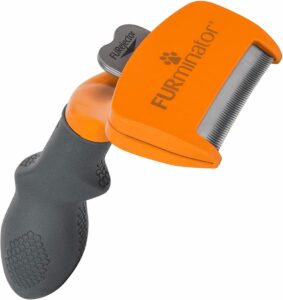
In our case, we’re looking at Shiba Inus specifically, which do shed heavily, but deshedding tools struggle to reach this breed’s undercoat, the layer of fur that they shed. Deshedding style brushes tend to snag on a Shiba’s overcoat, easily cutting or tearing it. This is a massive problem when you consider this breed’s overcoat rarely grows back correctly, if at all. I got this Furminator from amazon.
It’s best to avoid these types of brushes if you value your Shiba’s health and happiness. While these brushes are comfortable for us, constant cutting and snagging are very uncomfortable for them. A quick summary of the pros and cons are:
Pros
- A high-quality tool that’s both durable and comfortable to hold
- Is gentle on your dog’s skin
- Is great at removing loose fur on your pet’s overcoat
Cons
- Causes damage to a Shiba Inu’s overcoat
- Most pets find the constant tugging on their fur uncomfortable
- The quick release and self-cleaning are prone to breaking
Slicker Brushes
The slicker brush’s only goal is to remove as much loose fur as possible. They don’t target a single or overcoat like de-shedding tools and they don’t target a dog’s undercoat like undercoat rakes. Slicker brushes consist of several rows of bent needle-like bristles that hook and gently pull loose fur out of a dog’s coat. These types of brushes can be found with and without a self-cleaning feature, and I heavily recommend picking one that does. While not impossible to clean, they aren’t the easiest, the few extra dollars are easily worth it in my opinion.
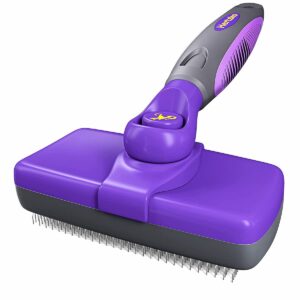
Believe it or not, slicker brushes are actually the best brush to use on a Shiba Inu. Their small spread-out metal bristles don’t cut or snag on any fur and easily remove loose fur from this breed’s undercoat. That broom-like array of bristles also helps distribute the Shiba’s natural oils throughout their coat. Dramatically improve the look and health of their fur. The specific one in the picture above isn’t sold anymore but I’ve lately been using a better one, the HERTZKO Self-Cleaning Slicker Brush from amazon.
I highly recommend you get a slicker brush for your Shiba Inu, but don’t cheap out. Cheaper slicker brushes tend to have rough or even sharp points at the ends of their bristles, which can scrape your Shiba’s skin, resulting in discomfort. Higher-quality ones remedy that problem by putting rounded plastic tips on the end of each bristle, the white dots in the photo above, and are well worth the money. Some of the pros and cons I’ve run into with slicker brushes are:
Pros
- Cause minimal damage to a Shiba Inu’s overcoat while removing loose undercoat fur
- Are comfortable and easy to use
- Helps reduce shedding and loose fur around your home.
Cons
- Cheaper ones have sharp pin-like bristles that catch and pull on your dog’s skin
- The self-cleaning mechanism can wear out over time
- The thin needle-like pins are prone to breaking off.
Undercoat Rakes
These types of brushes focus on grooming a dog’s undercoat specifically. They work best on large dogs or breeds with long fur. You’ll rarely see a self-cleaning feature on one of these, but you don’t need it, these brushes are incredibly easy to clean. While you can pick these brushes up for cheap, that doesn’t mean they’re uncomfortable to use, most have a nice nonslip contorted grip.
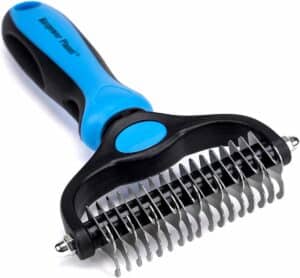
The problem with undercoat rakes is the style of fur they work best on. Shiba Inus do have a double coat, but their coats are generally short and they rarely remove any loose fur. I’ve tried two, a cheaper JW straight pin rake and a nicer Maxpower hooked rake, both from amazon, and neither of them was effective at removing my Shiba’s loose fur.
I recommend saving your money and skipping this type of brush if you are looking at Shiba Inus specifically. Just like the de-shedding tool, these are great for most pets but fall flat with this breed. A short summary of their pros and cons are:
Pros
- Most are comfortable to hold with a nice rubber grip
- They’re easy to clean
- Is easy on a Shiba’s fur, with minimal tugging
Cons
- Is harsh on your Shiba’s skin
- Doesn’t remove loose fur for some dogs, including Shiba Inus
- Some types use pins as bristles, which can be easy to break
The Best Brush For A Shiba Inu
Slicker brushes are the best choice for Shiba Inus. Shibas have a plush undercoat that constantly sheds and an overcoat that rarely grows back. The best type of brush minimized damage to their overcoat while easily removing loose fur from their undercoat with minimal discomfort.

As for a specific slicker brush, I recommend the HERTZKO Self-Cleaning Slicker Brush for dogs with sensitive skin. A long name, but let me explain.
The old slicker brush I had was from Chi, and has less than favorable reviews. The biggest issue I’ve run into is the actual tips of the bristles, they’re just cut metal, which causes a lot of discomfort.
I’ve also tried both a de-shedding tool and 2 different undercoat rakes.
- The Furminator regularly pulled out Faith’s overcoat, and she hated being brushed with it.
- The JW and Maxpower undercoat rakes thankfully didn’t cause any damage, but they also didn’t remove any fur for me.
Since switching for a slicker brush full-time, and preferably a slicker brush with plastic tips so I don’t scrape my dogs skin, Faith has loved being brushed. Regularly rolling over and lazily chewed on a toy with a big smile on her face. But there’s a bit more on why slicker brushes are the best for this breed. This is definitely the best dog brush for undercoats.
Why Picking The Right Brush Matters
Shiba Inus rely heavily on the different layers of their double coat to keep them clean and healthy.
Their overcoat is longer, generally 2 inches in length, and keeps them clean by repelling both dirt and water. It also acts like a furry suit of armor when they bump into things. This layer of their coat rarely grows back right when cut or shaved.
A Shiba’s undercoat is responsible for regulating their body heat. That constant, and at times excessive, shedding throughout the year is this layer of their coat. Their undercoat is light, plush, and constantly grows back. The reason they shed so heavily in the spring and fall seasons is to prepare for the warm summer and cold winter months.
With how vital their overcoat is, and the fact it doesn’t really grow back, picking the right bush that’ll minimize damage to their overcoat while easily removing their loose undercoat is crucial. You also want a brush that will help spread the natural oils in their skin and fur.
While there are many different types of dog brushes, slicker brushes have routinely filled this role the best. They:
- Cause minimal to no damage to a Shiba’s overcoat.
- Easily remove loose undercoat fur with little discomfort.
- Help spread their natural oils.
- And help keep both their skin and fur healthy by removing dirt, grim, and dander.
But picking the right brush for your Shiba Inu doesn’t just stop at their coat, it also helps you around the house.
A good slicker brush removes more loose fur than any other brush I’ve tested. This has helped minimize tumbleweeds, keep my furniture clean, and reduce the amount of fur I’ve found on my clothes. It also makes vacuuming easier, there’s less fur to clean up on average, and has reduced the number of times I’ve needed to vacuum each month.
How To Brush Your Shiba Inu
Before brushing your dog it’s best to make sure they are dry. Wet fur mats, resulting in discomfort and the removal of healthy fur. Brushing your pet while they’re dry also helps spread the natural oils found on their coat and skin across their entire body.
Grab your brush of choice and find a quiet place for your Shiba Inu to lie down. They don’t have to be lying, but some people find it easier. You can give them a chew toy or bone to keep them occupied. After getting them settled, you’ll want to:
Step 1) Gently run your brush down from your Shiba’s neck to the base of their tail. Pushing too hard will cause discomfort and may damage their coat. If you keep getting caught on a specific patch of fur, try running your brush in the opposite direction to break the tangled fur up.
Step 2) Continue that gentle head-to-tail brushing to their sides. Make sure you periodically clean out your brush, a clogged brush will only cause discomfort. With how much this breed sheds I recommend keeping a small bag or trash can nearby. If your Shiba Inu is like mine then they’ll eat the loose fur, which isn’t good for them.
Step 3) Once you feel their coat is thoroughly brushed run your hand along them to get any stragglers. Petting, rubbing, and playing in general are great ways to loosen dead fur so it can be brushed later.
Step 4) Done. If you have a dog comb you could run it through their fur to try fluffing it up if you want that fluffy Shiba look.
It’s important you stick to a schedule when grooming a Shiba Inu. As a double-coated dog, they shed regularly throughout the year and heavily during the first 3 weeks of March and September. You’ll want to brush them at least once a week and nearly daily while blowing their undercoat.
Summary
There are different types of brushes with varying features and qualities. A good brush will last for years, take a little extra time and spend a few extra dollars on one that’ll last.
When it comes to a specific type of brush that works best on Shiba Inus, it’s hard to beat a slicker brush, they’re:
- Cause little damage to their vital overcoat
- Fairly inexpensive
- Are effective yet comfortable
- And promote both good looks and health by spreading your dog’s natural oils
After finding a brush that works for you it’s important you stick to a schedule. Shiba Inus may be stubborn, but they are smart, routines and habits are their best friends. Shibas should be brushed once a week throughout the year and almost daily while they’re blowing their undercoat. Typically during the first 3 weeks of March and September.
Frequently Asked Questions
What Type Of Brush Is Best For A Shiba Inu?
Slicker brushes are the best brush for grooming Shiba Inus. They don’t damage their coats like a de-shedding tool, help spread the natural oils found on their skin and coat, and easily remove their loose undercoat with very little discomfort. Just make sure you don’t push down too hard.
Do Shiba Inus Like Being Brushed?
Shiba Inus are stubborn, independent, and aren’t fond of being handled at first. If you start early and stick to a consistent routine, it’s possible to get your Shiba Inu comfortable with being brushed. Take things slowly, be consistent, and make sure they’re comfortable.
Do Shiba Inus Need to be Groomed?
Even though Shiba Inus are a remarkably clean breed they still need to be regularly groomed. It’s best to brush a Shiba Inu weekly, daily during heavy shedding season, bathed every 2 to 4 months depending on their level of activity, and nails trimmed at least once a month.
How Often Should You Groom Your Shiba Inu?
Shiba Inus need to be brushed weekly, brushed daily during peak shedding season (first 3 weeks of March and September), bathed every 2 to 4 months depending on their level of activity, and have their nails trimmed at least monthly. It’s important you stick to a consistent schedule.
How Do You Brush A Shiba Inu?
To avoid damaging a Shiba Inus overcoat it’s best to gently brush them from head to tail using a slicker brush. Make sure you don’t push down too hard to minimize discomfort, regularly clean loose fur stuck to the bristles of the brush, and give them a toy or treat to keep them occupied.
How Do I Get My Shiba Inu To Stop Shedding?
Unfortunately, there is no way to prevent a Shiba Inu from shedding, but there are ways to minimize it. Stick to a routine by brushing them at least once a week, slicker brushes are the best for this breed, and regularly vacuum your living space.
Is It OK To Shave A Shiba Inu?
While brushing a Shiba Inu’s coat can be a chore, shaving them permanently ruins their double coat. Shiba Inus are a double-coated breed, their overcoat helps keep them clean while their undercoat regulates body heat, their undercoat is what constantly sheds. Their overcoat does not grow back.
